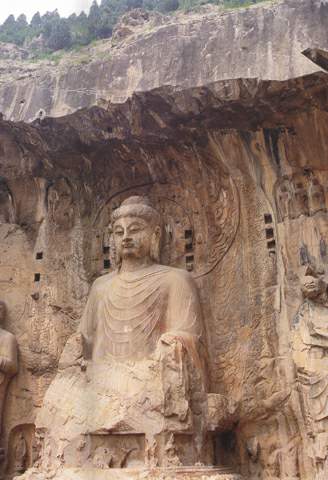Longmen Grottoes lie 12 kilometers to the south of the Luoyan City, Henan Province.
 |
|
Longmen Grottoes are one of the three most famous treasure houses of Chinese grotto art. Here two mountains, namely, East Hill (Mt. Xiangshan) and West Hill (Mt. Longmen), confront each other with the Yi River traversing northward between them, just like a pair of Chinese gate towers. So during the Zhou and Qin dynasties, it was called "Yi Que" (Gate of Yi River). Later, when the Sui established its capital city in Luoyang, the palace gate was just facing Yi Que, hence the name "Longmen" which means "Dragon Gate". Spanning a length of over 1,000 meters on the hillsides along the Yi River, the Longmen Grottoes were first sculptured and chiseled around 493 when the capital of the Northern Wei Dynasty (386-534) was moved from Datong to Luoyang. The entire construction of the Longmen Grottoes lasted more than four hundred years through the Northern Dynasties (386-581), the Sui Dynasty (581-618), the Tang Dynasty (618-907) and up to the Song Dynasty (960-1279). The extant grottoes include the Qianxi Temple (Hidden Stream Temple), the Binyang Cave, the Lianhua Cave (Lotus Cave), the Fengxian Temple, the Guyang Cave, the Kanjing Temple of the East Hill and so on. In total, there are 2,100 niches, 43 stupas, 3,600 square meters of inscriptions and epigraphs, and 100,000 small or big statues, among which the biggest statue is 17.14 meters high and the smallest is only 2 centimeters high.
The Guyang Cave, sculpted between 495 and 575, is regarded as the earliest of the Longmen Grottoes. There are three tiers of niches engraved on either side of the cave. The arch top and the places behind the Buddha statue were sculpted into abundant and colorful designs. The statues of providers look devout and prudent, with the dynamic lines of their clothes. In addition, there is a superb collection of epigraphs of the statues inside the cave, which is really a feast for the eyes because of the simple and natural calligraphies. Nine pieces of what is called Twenty Calligraphic Gem in the Longmen Grottoes are stored in this cave, and are treasures for the research of the calligraphic art.
The Binyang Cave, which was ordered to sculpt by Emperor Xuanwu for the purpose of commemorating Emperor Xiaowen and Queen Wenzhao, is of the biggest scale among the grottoes of the Northern Wei Dynasty. It was first chiseled in the first year (500) of the Jingming reign, and completed in the fourth year (523) of the Zhengguang reign, which took 800,000 workers 24 years to accomplish it. Inside the cave, there is a statue of Sakyamuni, 8.4 meters high, on either side of which stand statues of two disciples and two Bodhisattvas, which is the typical combined sculpture of the five statues. The statues, with comely appearances and regular pleats of the clothes, evidently represent the artistic style of the Northern Wei Dynasty. On the top of the cave there are the carvings of lotus canopies and free Flying Apsaras. Huge carvings in relief are all over the walls, including four layers of paintings such asthe Teaching of Vimalakirti,the Natural Stories of the Buddha,the Paintings of Ten Gods. Besides, there used to be two huge relief sculptures in the cave depicting the grand scenes of the worshipping ceremonies of Emperor Xiaowen and his wife. But, later, these were stolen and now are housed respectively by museums in Texas and New York.
The Cave of Prescription, possessing the artistic styles of the last years of the Northern Wei Dynasty, has obtained its name because of the engraved prescriptions of curing more than 140 diseases such as malaria, tummy bug, heartache, murrain and so on, and therefore provides precious resources for the research into the ancient Chinese pharmacy and medicine science.
The Fengxian Temple is of the biggest scale and highest artistic values among the Longmen Grottoes. It was built with the support of Empress Wu Zetian who donated much money in the second year (675) of the Shangyuan reign of Tang Emperor Gaozong. The niche is 36 meters wide from the north to the south, and 41 meters high. The most extraordinary statue in Fengxian Temple is the Grand Vairocana Buddha, which is 17.14 meters tall with his head 4 meters long and his ear 1.9 meters wide. Sitting in the middle of the niche, this colossal Buddha shows a perfect combination of moral integrity, delicate emotions, broad mind and elegant semblance. Her lips are slightly upturned and her head a little bit lowered, a slight smile makes her look like a sagacious and benign middle-aged woman whom you would respect but not fear. On either side of it stand nine statues of disciples, Bodhisattvas, Heavenly Kings and Hercules, and each has its vivid posture and expressions. For instance, the disciple named Jiaye looks careful and wise, and A'nan looks respectful and compliant; while the Bodhisattvas look dignified and missish, and the Heavenly King look martial and dynamic, filled with heroic spirit. This group of statues displays consummate carving art, and represents the high achievements of the sculpture art in the most prosperous period of the Tang Dynasty.
The sculpture art of the Longmen Grottoes integrates the conventionalization and nationalization, totally breaking away from the mysterious senses of the sculpture art in the early stage and the external influences. The statues completed during the most prosperous period of the Tang Dynasty brim with energy and vitality, and are cheerful and unrestrained, which are the outstanding ones of the ancient China's sculptural artworks and represent the sculptural level of that time.
